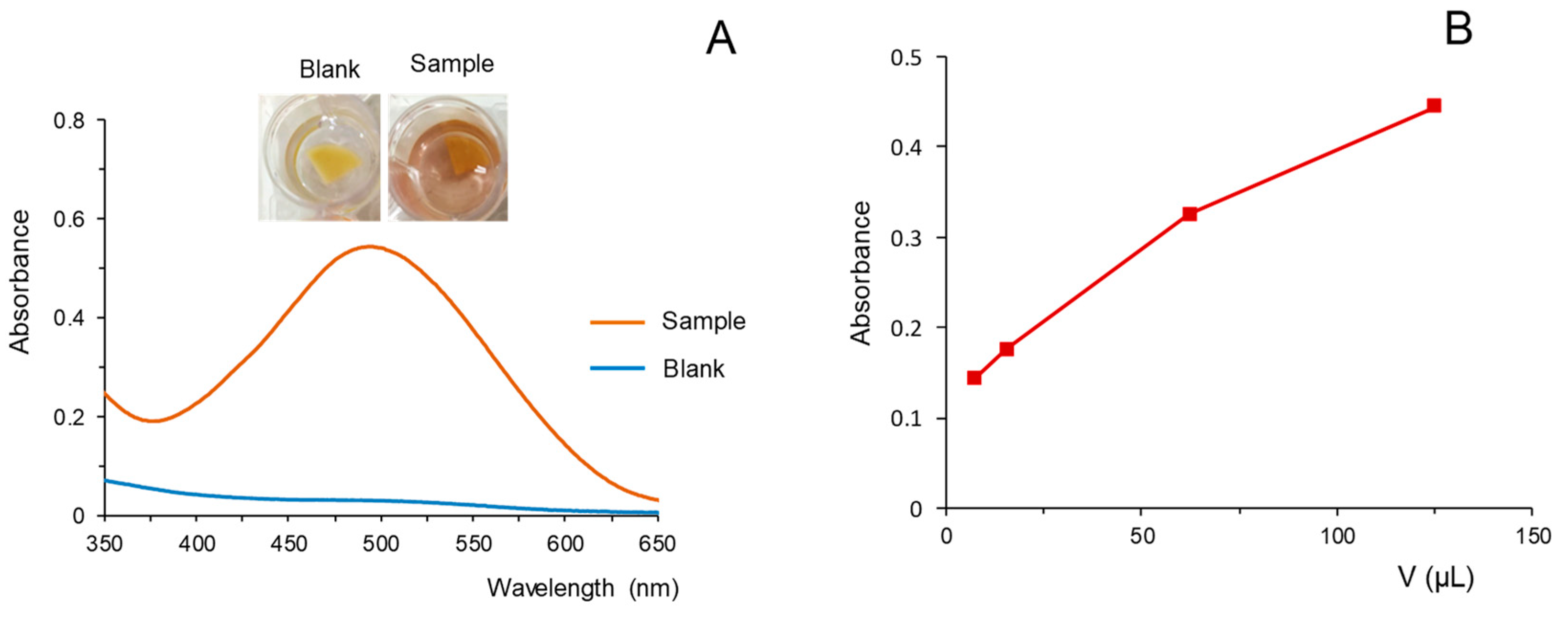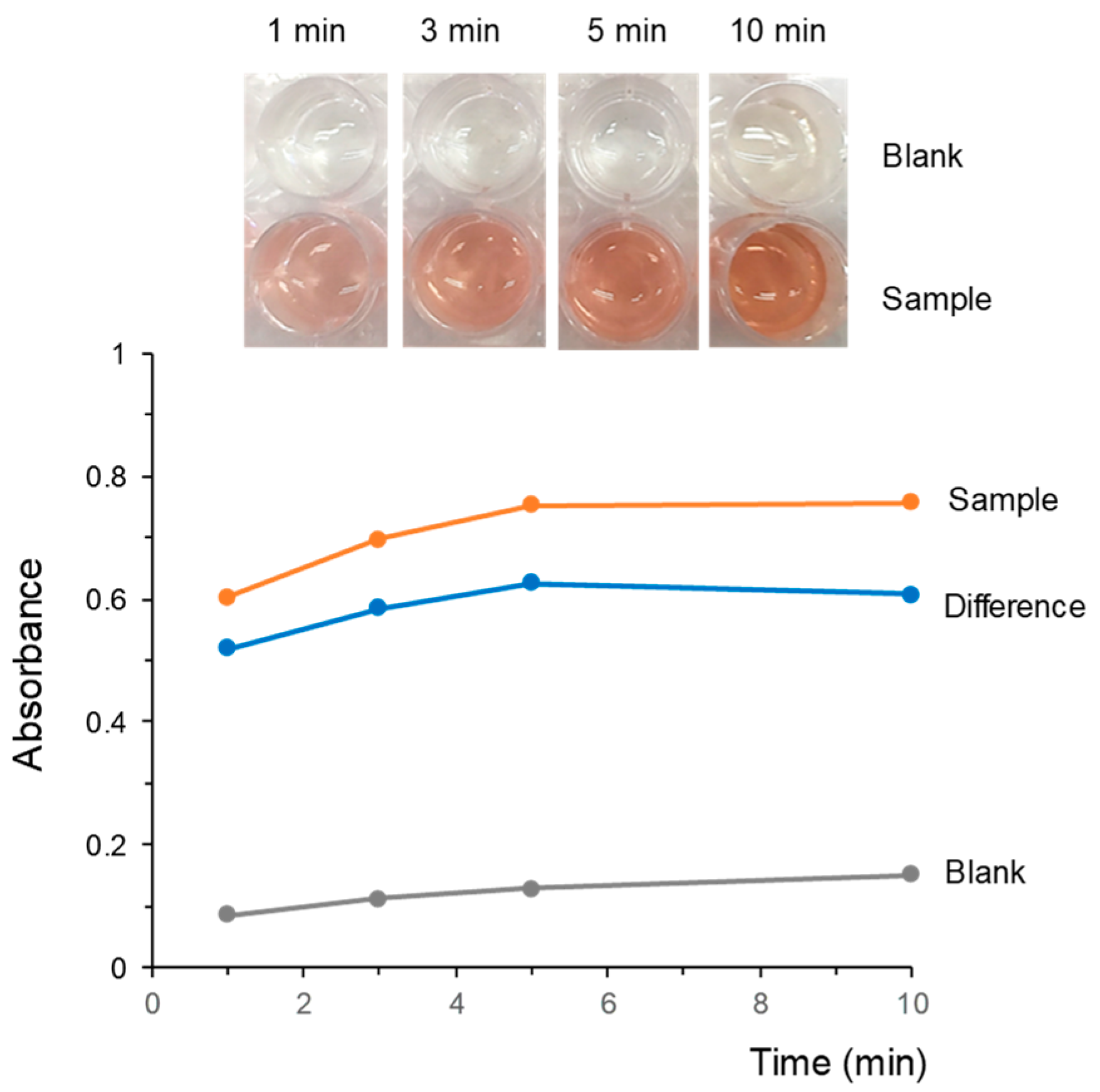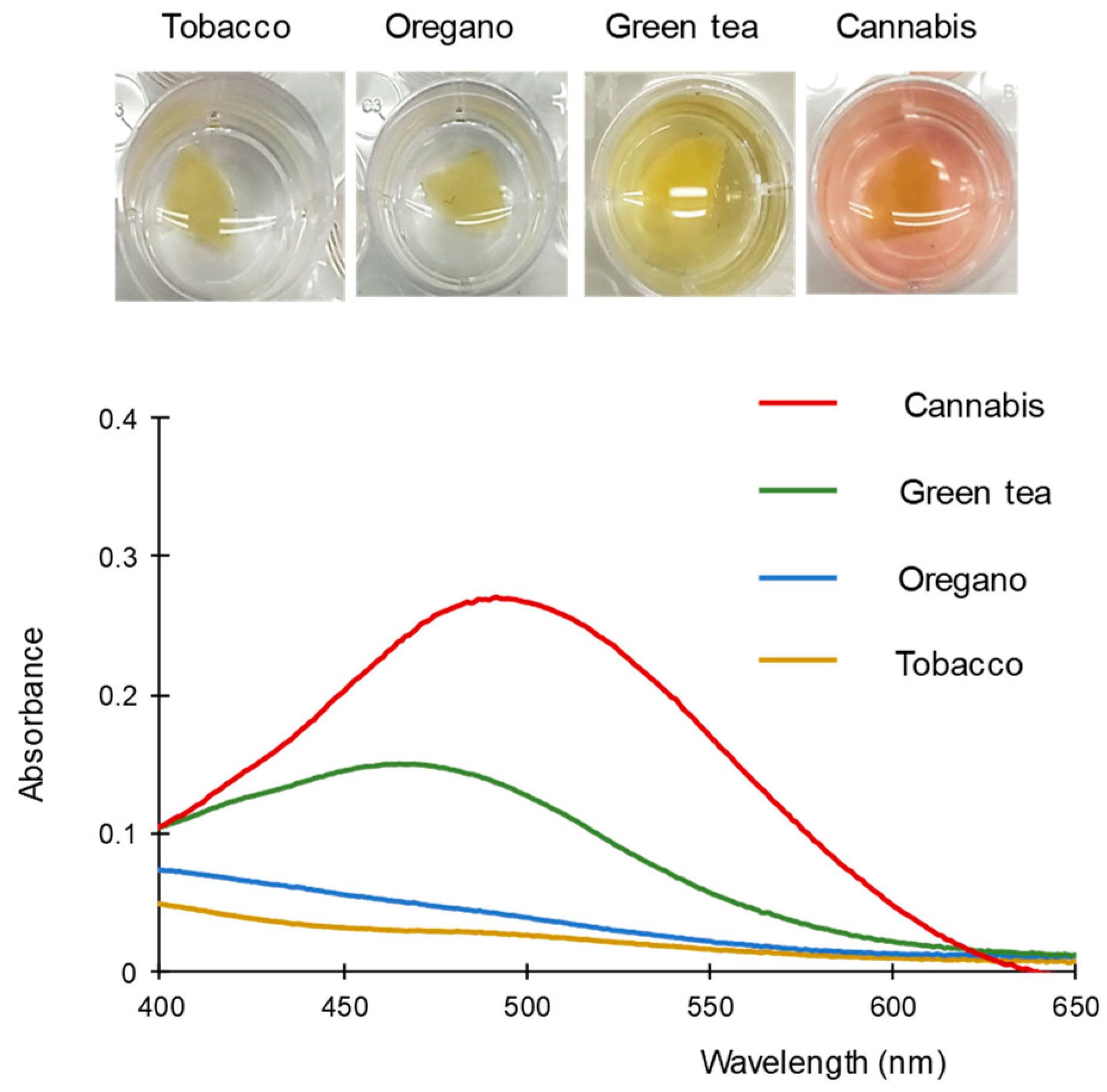A Colorimetric Method for the Rapid Estimation of the Total Cannabinoid Content in Cannabis Samples
Abstract
1. Introduction
2. Results
2.1. Reaction in Solution
2.2. Reaction with FBB Immobilized into PDMS
2.2.1. Study of the Reaction
2.2.2. Selectivity
2.2.3. Application to Cannabis Samples
3. Discussion
4. Materials and Methods
4.1. Reagents and Solutions
4.2. Instrumentation and Conditions
4.3. Preparation of the FBB/PDMS Composites
4.4. Reaction Conditions
4.5. Analysis of the Cannabis Samples
5. Conclusions
Supplementary Materials
Author Contributions
Funding
Institutional Review Board Statement
Informed Consent Statement
Data Availability Statement
Conflicts of Interest
Sample Availability
References
- Welling, M.T.; Liu, L.; Hazekamp, A.; Dowell, A.; King, G.J. Developing Robust Standardised Analytical Procedures for Cannabinoid Quantification: Laying the Foundations for an Emerging Cannabis-Based Pharmaceutical Industry. Med. Cannabis Cannabinoids 2019, 2, 1–13. [Google Scholar] [CrossRef] [PubMed]
- Brighenti, V.; Protti, M.; Anceschi, L.; Zanardi, C.; Mercolini, L.; Pellati, F. Emerging challenges in the extraction, analysis and bioanalysis of cannabidiol and related compounds. J. Pharm. Biomed. Anal. 2021, 192, 113633. [Google Scholar] [CrossRef] [PubMed]
- Patel, B.; Wene, D.; Fan, Z.T. Qualitative and quantitative measurement of cannabinoids in cannabis using modified HPLC/DAD method. J. Pharm. Biomed. Anal. 2017, 146, 15–23. [Google Scholar] [CrossRef] [PubMed]
- Zivovinovic, S.; Alder, R.; Allenspach, M.D.; Steuer, C. Determination of cannabinoids in Cannabis sativa L. samples for recreational, medical, and forensic purposes by reversed-phase liquid chromatography-ultraviolet detection. J. Anal. Sci. Technol. 2018, 9, 27–37. [Google Scholar] [CrossRef]
- Citti, C.; Braghiroli, D.; Vandelli, M.A.; Cannazza, G. Pharmaceutical and biomedical analysis of cannabinoids: A critical review. J. Pharm. Biomed. Anal. 2021, 147, 565–579. [Google Scholar] [CrossRef]
- Deidda, R.; Dispas, A.; De Bleye, C.; Hubert, P.; Ziemons, E. Critical review on recent trends in cannabinoid determination on cannabis herbal samples: From chromatographic to vibrational spectroscopic techniques. Anal. Chim. Acta 2022, 1209, 339184. [Google Scholar] [CrossRef]
- Ciolino, L.A.; Ranieri, T.L.; Taylor, A.M. Commercial cannabis consumer products part 2: HPLC-DAD quantitative analysis of cannabis cannabinoids. Forensic Sci. Int. 2018, 289, 438–447. [Google Scholar] [CrossRef]
- Deville, M.; Dubois, N.; Denooz, R.; Charlier, C. Validation of an UHPLC/DAD method for the determination of cannabinoids in seized materials: Analysis of 213 samples sold in Belgian CBD shops. Forensic Sci. Int. 2020, 310, 110234. [Google Scholar] [CrossRef]
- McRae, G.; Melanson, J.E. Quantitative determination and validation of 17 cannabinoids in cannabis and hemp using liquid chromatography-tandem mass spectrometry. Anal. Bioanal. Chem. 2020, 412, 7381–7393. [Google Scholar] [CrossRef]
- Nahar, L.; Onder, A.; Sarker, S.D. A review on the recent advances in HPLC, UHPLC and UPLC analyses of naturally occurring cannabinoids (2010–2019). Phytochem. Anal. 2020, 31, 413–457. [Google Scholar] [CrossRef]
- Žampachová, L.; Aturki, Z.; Mariani, F.; Bednář, P. A Rapid Nano-Liquid Chromatographic Method for the Analysis of Cannabinoids in Cannabis sativa L. Extracts. Molecules 2021, 26, 1825. [Google Scholar] [CrossRef] [PubMed]
- Zekič, J.; Križman, M. Development of Gas-Chromatographic Method for Simultaneous Determination of Cannabinoids and Terpenes in Hemp. Molecules 2020, 25, 5872. [Google Scholar] [CrossRef]
- dos Santos, N.A.; Souza, L.M.; Domingos, E.; França, H.S.; Lacerda, V., Jr.; Beatriz, A.; Vaz, B.G.; Rodrigues, R.R.T.; Carvalho, V.V.; Merlo, B.B.; et al. Evaluating the selectivity of colorimetric test (Fast Blue BB salt) for the cannabinoids identification in marijuana street samples by UV–Vis, TLC, ESI(+)FT-ICR MS and ESI(+)MS/MS. Forensic Chem. 2016, 1, 13–21. [Google Scholar] [CrossRef]
- Mano-Sousa, B.J.; Maia, G.A.S.; Lima, P.L.; Campos, V.A.; Negri, G.; Chequer, F.M.D.; Duarte-Almeida, J.M. Color determination method and evaluation of methods for the detection of cannabinoids by thin-layer chromatography (TLC). J. Forensic Sci. 2020, 66, 854–865. [Google Scholar] [CrossRef] [PubMed]
- Harpaz, D.; Bernstein, N.; Namdar, D.; Eltzov, E. Portable biosensors for rapid on-site determination of cannabinoids in cannabis, a review. Biotechnol. Adv. 2022, 61, 108031. [Google Scholar] [CrossRef] [PubMed]
- Sánchez-Carnerero Callado, C.; Núñez-Sánchez, N.; Casano, S.; Ferreiro-Vera, C. The potential of near infrared spectroscopy to estimate the content of cannabinoids in Cannabis sativa L.: A comparative study. Talanta 2018, 190, 147–157. [Google Scholar] [CrossRef]
- Brighenti, V.; Marchetti, L.; Anceschi, L.; Protti, M.; Verri, P.; Pollastro, F.; Mercolini, L.; Bertelli, D.; Zanardi, C.; Pellati, F. Separation and non-separation methods for the analysis of cannabinoids in Cannabis sativa L. J. Pharm. Biomed. Anal. 2021, 206, 114346. [Google Scholar] [CrossRef]
- Bruci, Z.; Papoutsis, I.; Athanaselis, S.; Nikolaou, P.; Pazari, E.; Spiliopoulou, C.; Vyshka, G. First systematic evaluation of the potency of Cannabis sativa plants grown in Albania. Forensic Sci. Int. 2012, 222, 40–46. [Google Scholar] [CrossRef]
- Cardenia, V.; Toschi, T.G.; Scappini, S.; Rubino, R.C.; Rodriguez-Estrada, M.T. Development and validation of a Fast gas chromatography/mass spectrometry method for the determination of cannabinoids in Cannabis sativa L. J. Food Drug Anal. 2018, 26, 1283. [Google Scholar] [CrossRef]
- Watanabe, K.; Yamaki, E.; Yamamoto, I.; Yoshimura, H. A colorimetric method for the determination of cannabinoids with Fast Blue BB salt. Eisei Kagaku 1979, 25, 321–326. [Google Scholar] [CrossRef]
- Hakobyan, L.; Prieto-Blanco, M.C.; Llorens, M.R.; Molins-Legua, C.; Fuster-Garcia, M.; Moliner-Martinez, Y.; Campins-Falcó, P.; Ribes-Koninckx, C. Fast blue B functionalized silica-polymer composite to evaluate 3,5-dihydroxyhydrocinnamic acid as biomarker of gluten intake. Sens. Actuators B Chem. 2021, 345, 130333. [Google Scholar] [CrossRef]
- Argente-García, A.; Jornet-Martínez, N.; Herráez-Hernández, R.; Campíns-Falcó, P. A solid colorimetric sensor for the analysis of amphetamine-like street samples. Anal. Chim. Acta 2016, 943, 123–130. [Google Scholar] [CrossRef]
- Argente-García, A.; Jornet-Martínez, N.; Herráez-Hernández, R.; Campíns-Falcó, P. A passive solid sensor for in-situ colorimetric estimation of the presence of ketamine in illicit drug samples. Sens. Actuators B Chem. 2017, 253, 1137–1144. [Google Scholar] [CrossRef]
- Jornet-Martínez, N.; Herráez-Hernández, R.; Campíns-Falcó, P. Scopolamine analysis in beverages: Bicolorimetric device vs portable nano liquid chromatography. Talanta 2021, 232, 122406. [Google Scholar] [CrossRef] [PubMed]
- Jornet-Martínez, N.; Campíns-Falcó, P.; Herráez-Hernández, R. A Colorimetric Membrane-Based Sensor with Improved Selectivity towards Amphetamine. Molecules 2021, 26, 6713. [Google Scholar] [CrossRef]
- Jornet-Martínez, N.; Samper-Avilés, M.; Herráez-Hernández, R.; Campíns-Falcó, P. Modifying the reactivity of copper (II) by its encapsulation into polydimethylsiloxane: A selective sensor for ephedrine-like compounds. Talanta 2019, 196, 300–308. [Google Scholar] [CrossRef] [PubMed]
- Jornet-Martínez, N.; Herráez-Hernández, R.; Campíns-Falcó, P. Stabilization of formaldehyde into polydimethylsiloxane composite: Application to the in situ determination of illicit drugs. Anal. Bioanal. Chem. 2019, 411, 2141–2148. [Google Scholar] [CrossRef]
- Liu, Y.; Liu, H.-Y.; Li, S.-H.; Ma, W.; Wu, D.-T.; Li, H.-B.; Xiao, A.-P.; Liu, L.-L.; Zhu, F.; Gana, R.-Y. Cannabis sativa bioactive compounds and their extraction, separation, purification, and identification technologies: An updated review. TrAC Trends Anal. Chem. 2022, 149, 116554. [Google Scholar] [CrossRef]
- Musile, G.; Wang, L.; Bottoms, J.; Tagliaro, F.; McCord, B. The development of paper microfluidic devices for presumptive drug detection. Anal. Methods 2015, 7, 8025–8033. [Google Scholar] [CrossRef]
- IUPAC. Harmonised guidelines for the ue of recovery information in analytical measurement. Pure Appl. Chem. 1999, 71, 337–348. [Google Scholar] [CrossRef]
- United Nation Office on Drugs and Crime (UNDOC). Drug Market Rrends of Cannabis and Opioids. Available online: https://www.unodc.org/ (accessed on 2 December 2022).
- Gul, W.; Gul, S.W.; Radwan, M.M.; Wanas, A.S.; Mehmedic, Z.; Khan, I.; Sharaf, M.H.; ElSohly, M.A. Determination of 11 Cannabinoids in Biomass and Extracts of Different Varieties of Cannabis Using High-Performance Liquid Chromatography. J. AOAC Int. 2015, 98, 1523–1528. [Google Scholar] [CrossRef] [PubMed]
- Ambach, L.; Penitschka, F.; Broillet, A.; König, S.; Weinmann, W. Simultaneous quantification of delta-9-THC, THC-acid A, CBN and CBD in seized drugs using HPLC-DAD. Forensic Sci. Int. 2014, 243, 107–111. [Google Scholar] [CrossRef] [PubMed]
- Ahmed, A.Q.; Noshad, D.; Li, P.C.H. Quantification of Cannabinoids in Cultivars of Cannabis sp. by Gas Chromatography–Mass Spectrometry. Chromatographia 2021, 84, 711–717. [Google Scholar] [CrossRef]






| Sample | Volume of Ethanolic Extract in the Reaction Solution 1 (µL) | Content of Cannabinoids, Expressed as CBD (%) |
|---|---|---|
| S1 | 25 | 22.5 ± 0.13 |
| S1 | 50 | 23.7 ± 1.0 |
| S2 | 50 | 16.8 ± 1.3 |
| S3 | 50 | 14.2 ± 1.3 |
| S4 | 50 | 10.9 ± 0.6 |
| S5 | 50 | 18.6 ± 0.8 |
Disclaimer/Publisher’s Note: The statements, opinions and data contained in all publications are solely those of the individual author(s) and contributor(s) and not of MDPI and/or the editor(s). MDPI and/or the editor(s) disclaim responsibility for any injury to people or property resulting from any ideas, methods, instructions or products referred to in the content. |
© 2023 by the authors. Licensee MDPI, Basel, Switzerland. This article is an open access article distributed under the terms and conditions of the Creative Commons Attribution (CC BY) license (https://creativecommons.org/licenses/by/4.0/).
Share and Cite
Jornet-Martínez, N.; Biosca-Micó, J.; Campíns-Falcó, P.; Herráez-Hernández, R. A Colorimetric Method for the Rapid Estimation of the Total Cannabinoid Content in Cannabis Samples. Molecules 2023, 28, 1303. https://doi.org/10.3390/molecules28031303
Jornet-Martínez N, Biosca-Micó J, Campíns-Falcó P, Herráez-Hernández R. A Colorimetric Method for the Rapid Estimation of the Total Cannabinoid Content in Cannabis Samples. Molecules. 2023; 28(3):1303. https://doi.org/10.3390/molecules28031303
Chicago/Turabian StyleJornet-Martínez, Neus, Josep Biosca-Micó, Pilar Campíns-Falcó, and Rosa Herráez-Hernández. 2023. "A Colorimetric Method for the Rapid Estimation of the Total Cannabinoid Content in Cannabis Samples" Molecules 28, no. 3: 1303. https://doi.org/10.3390/molecules28031303
APA StyleJornet-Martínez, N., Biosca-Micó, J., Campíns-Falcó, P., & Herráez-Hernández, R. (2023). A Colorimetric Method for the Rapid Estimation of the Total Cannabinoid Content in Cannabis Samples. Molecules, 28(3), 1303. https://doi.org/10.3390/molecules28031303








